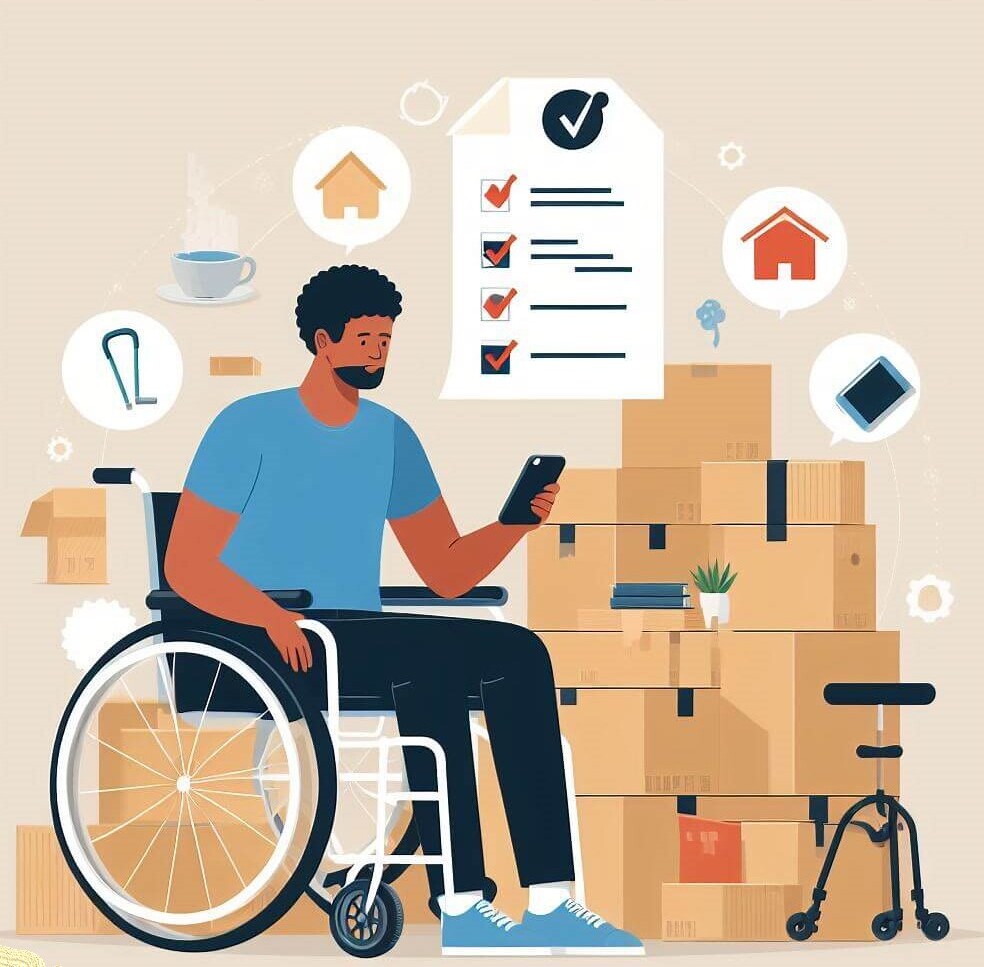Accessible Solutions and Resources For Moving with a Disability
Understanding the Challenges
Moving can be physically demanding and mentally taxing for anyone, but when you have a disability, these challenges are often amplified. Mobility issues, chronic pain, or limited dexterity can make packing, lifting, and transporting items a significant challenge.
Ensuring both your current and new homes are accessible can be a hurdle, as not all properties are designed with disabilities in mind. 
Moving is emotionally taxing for everyone, but the added stress of managing a disability can be overwhelming.
Sometimes, individuals with disabilities may lack a robust support system, making tasks like heavy lifting even more daunting.
Despite these challenges, there are several accessible solutions and resources to help ease the moving process for individuals with disabilities.
Start with a Detailed Plan
Moving to a new residence is a significant life event, and it’s a process that can quickly become overwhelming. Whether you’re moving to a different city or just down the street, having a well-structured plan is the key to a successful and less stressful move.
A plan provides structure, ensuring that you’re organized throughout the entire process. You’ll know what needs to be done and when.
A well-constructed plan helps you allocate time effectively. It prevents last-minute rushes and ensures that you have ample time to complete each task.
A plan minimizes the stress often associated with moving. Knowing that you have a roadmap to follow can provide a sense of control.
Planning in advance helps you budget effectively and prevents unnecessary expenses. You can identify costs and prioritize spending.
Determine the date of your move and work backward to establish a timeline. Identify the key milestones and tasks that need to be completed before, during, and after the move.
Compile a checklist of all the tasks you need to complete. This should include everything from decluttering, packing, and hiring movers to notifying utilities and updating your address.
Not all tasks are equally important. Prioritize the items on your checklist based on deadlines and importance. For example, securing a new home or hiring movers should be top priorities.
Determine your budget for the move and allocate costs to different tasks. Be realistic and make allowances for unexpected expenses.
Before packing, take the time to declutter. This is the perfect opportunity to reduce the number of items you need to move. Make an inventory of your belongings to keep track of what you’re taking with you.
Plan your packing strategy. Decide which items you’ll pack first and which will be packed last. Label your boxes clearly and consider packing separately for easy access.
Make a list of service providers, such as utilities, internet, and medical services, that need to be notified of your move. Contact them well in advance to avoid any disruptions.
Unexpected circumstances can arise, so be prepared to adjust your plan as needed. Having a well-thought-out plan provides a solid foundation, but flexibility allows you to adapt to changing situations.
Professional Movers with Experience
When it comes to moving to a new residence, whether it’s across town or across the country, having the right team of movers by your side is paramount. Professional movers with experience can turn a potentially daunting and stressful process into a smooth and efficient transition to your new home.
Experienced movers have in-depth knowledge of the logistics involved in a move. They are well-versed in packing, loading, transportation, and unloading processes.
Professionals are skilled at maximizing space within moving vehicles, which can reduce the number of trips required and save you time and money.
Professional movers work efficiently, allowing you to focus on other important aspects of your move, such as paperwork and settling into your new home.
Moving can be physically demanding, but hiring professionals means you won’t have to lift heavy items or risk injuring yourself.
If you have a disability, it’s important to communicate your specific requirements with the moving company. Experienced movers should be sensitive to your needs and be able to accommodate them. This may include providing accessible moving equipment, additional assistance, or taking extra care with mobility aids or medical equipment.
Accessibility Audits
Accessibility audits are a vital step when moving into a new home, especially for individuals with disabilities. These audits involve evaluating both your current and new living spaces to identify potential barriers and making necessary modifications to ensure a safe and accessible environment.
These audits pinpoint any architectural or design features that might hinder mobility or independence for individuals with disabilities. This includes issues like narrow doorways, uneven flooring, or a lack of ramps.
Once barriers are identified, an accessibility audit allows you to plan and prioritize necessary modifications. This might include installing ramps, handrails, or accessible fixtures.
For new homes, accessibility audits help ensure compliance with accessibility standards and regulations, such as the Americans with Disabilities Act (ADA) in the United States.
By addressing accessibility concerns, you create a safer living environment for everyone, reducing the risk of accidents or injuries.
You have the option to conduct your own accessibility audit or hire professionals. While a DIY audit can provide valuable insights, professionals, such as architects or consultants with experience in accessible design, can offer a more comprehensive evaluation and expert guidance.
Reach Out for Assistance
Don’t hesitate to ask for help from friends, family, or community organizations. A support system can make all the difference during a move. If you lack a local support network, consider reaching out to organizations that specialize in assisting individuals with disabilities during the moving process.
Many regions have disability support organizations that offer assistance, advice, and resources for individuals with disabilities. These organizations can help you connect with relevant services.
Some moving companies specialize in disability-friendly moves. They can provide accessible packing materials, equipment, and experienced professionals who understand the unique needs of individuals with disabilities.
Joining local or online support groups for people with disabilities can be a valuable resource. Members can share their moving experiences, offer tips, and provide emotional support.
Investigate local resources, such as volunteer groups or charitable organizations, that may offer assistance or services to those with disabilities during a move.
Utilize Moving and Packing Services
Many moving companies offer packing services. This can be especially helpful if you have limited mobility or find the packing process physically challenging. Professional packers can efficiently and securely pack your belongings, alleviating the burden on you.
Take Advantage of Government Programs
Government programs in NYC are designed to support and assist individuals, including those with disabilities, during various life events, including residential moves. These programs can provide financial aid, resources, and specialized services to help make the process more accessible and manageable.
To take advantage of these programs, you’ll typically need to meet specific eligibility criteria, such as income requirements, disability status, or other relevant factors. Each program will have its own application process, and it’s important to thoroughly understand the requirements and documentation needed.
Government programs can have application deadlines and limited funding. Act promptly to secure the support and resources you need for your move.
Accessible Transportation
When planning the move, ensure you have accessible transportation options. Verify that the moving company has accessible vehicles and equipment to accommodate your needs.
Accessible transportation allows individuals with disabilities to maintain their independence and freedom of movement, reducing reliance on others for mobility.
Accessible vehicles are equipped with features that enhance safety for passengers with disabilities, such as secure restraints and ramps.
These vehicles are often designed with comfort in mind, offering features like spacious interiors and climate control systems.
Emotional Support
Don’t hesitate to reach out to friends and family. Let them know what you’re going through, and express your needs. Sometimes, all it takes is a conversation to receive the support you require.
If you see someone going through a move, offer your support. Extend a helping hand, lend a listening ear, or simply check in on them.
Effective communication is key to both seeking and offering emotional support. Be open about your feelings and needs, and encourage others to do the same.
While supporting others, remember to practice self-care. Moving can be emotionally taxing, so take breaks, engage in activities you enjoy, and prioritize your well-being.
Other posts
© 2025 Local Movers. All rights reserved.
